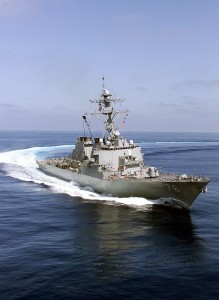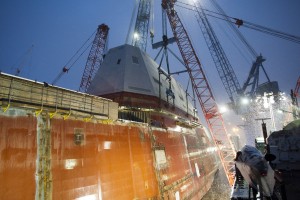 Reports claim that General Dynamics Bath Ironworks is trying to force the Navy to grant it a cost-plus contract to build the initial Flight III DDG-51 destroyer. The cost-plus request is a real head-scratcher for observers–and it is an action that should concern every Blue-Water Navalist out there.
Reports claim that General Dynamics Bath Ironworks is trying to force the Navy to grant it a cost-plus contract to build the initial Flight III DDG-51 destroyer. The cost-plus request is a real head-scratcher for observers–and it is an action that should concern every Blue-Water Navalist out there.
Obviously, a cost-plus proposal is a pretty dramatic step for Bath to take–particularly given the competition and the current political and budget environment.
It is unlikely a Trump Administration SECNAV will respond well to any cost-plus contract.
What made Bath do this?
Bath’s request for a cost-plus contract is a huge vote of “no confidence” in the Flight III DDG-51 “Variant”. I share their concern. The ship will be power-dense, built for tech that isn’t ready, and it’ll be pushing against the very last margins salted away by 1980’s era naval architects. A single miscalculation could unravel the whole platform–and the progression of war (particularly Electronic Warfare) is going to force last-second requirements change. It’s going to be a mess, and I’ve been worried about it for some time.
By now, Bath knows the signs of a problem program, having been through the ringer with the first-in-class (and ultimately orphaned) three-ship DDG-1000 production run. Making matters worse, Bath doesn’t have any other projects underway to absorb or efficiently use labor–if there is a design hiccup, labor will be wasted (whereas spare labor at Ingalls can be sent off to work one of, oh, four (?) shipbuilding programs currently underway in Mississippi.
But, as the DDG-51 is the mainstay US surface combatant, we should all take a deep breath and ask some probing questions about why Bath–of all the yards out there–is balking. The DDG-51 is a “Bath” product. It made “The Yard”.
This contractual equivalent of a slap in the customer’s face may reflect real concern that the Flight III design isn’t ready. Certainly, it is tough to ask what is, essentially, a single-product, labor-challenged shipyard, to take the “first-in-class” beating all over again. But, given the interest (and capital improvements) Bath has in trying to keep the DDG-1000 alive in some (any!) form, this fracas may well be a strategy to try and force the Navy to cough up a more accurate estimate of the Flight III DDG-51 cost, making the DDG-1000 price look better.
Both factors are likely in play here.
 Fighting For Fixed Price
Fighting For Fixed Price
I had the opportunity to discuss all this with the Times Record’s Nathan Strout, reminding Bath that:
For shipbuilding, cost-plus contracts have an important role in mitigating the shipbuilder’s risk of taking on a new contract for a fledgling naval ship — new shipbuilding programs mean the yard must retool, train new people, and gamble on the longer-term future of a program that is, very often, uncertain
Of course, Acting Secretary of the Navy Sean Stackley (Congrats!) will quietly recall that Bath has a long record with the Burke Class. The Flight III Arleigh Burke Destroyer is a variant of a ship Bath Ironworks has been designing and building since the late eighties. The first ship of this class, the USS Arleigh Burke, was awarded to Bath more than thirty years ago, and Bath Ironworks built more than half of the sixty-two Arleigh Burke destroyers that have been delivered to the U.S. Navy to date.
And finally, Bath has been awarded five Arleigh Burke contracts (an initial Flight IIa and four Flight IIa “tech inserts”) that are, essentially, exercises in Flight III risk reduction.
To an outsider (or to Bath’s mortal rival, Huntington Ingalls), the risks should be pretty manageable by now. And, frankly, overall, General Dynamics has a strong record of responding to design challenges in other programs. General Dynamics Electric Boat accepted–and earned a profit–after accepting fixed price contracts on variants of the Virginia Class submarine. The intra-variant design changes were significant, but the company responded with a fixed-price bid and did quite well.
But it’s not that easy:
According to Hooper, both sides have a point. On the one hand, the Navy can say that BIW has made dozens of Arleigh Burke-class destroyers and should be capable of making appropriate estimates. On the other hand, there are some major changes being made with the Flight III program, and the kinks have yet to be worked out. A report from the Government Accountability Office in August actually called for the Flight III program to be delayed in order to give the Navy time to increase design knowledge.
“The risks are high; the design isn’t ready to be built yet and the platform’s weight, power and space margins are slim enough that even a small design oversight could be catastrophic,” said Hooper. “But even given the risks, Bath’s request for cost-plus contract is a tough pill to force upon Washington, D.C. right now.
If I were a shipbuilder, I’d be terrified of integrating a still-immature radar into a very dense ship that has no margins. It’d be the shipbuilder–not the radar maker or the system integrator–who’d be on the butt end of angry Presidential Tweets about cost overruns.
The risk that the Flight III design will change between now and the mid-2020s is very high. The naval battle over spectrum and electrical-powered warfare is being fought today. Electronic warfare developments are coming quickly, and any metal-bending platform developer, sitting around at the wrong end of the technology development cycle, is going to be pressed by the customer to modify and incorporate new items to support new electronic and spectrum warfare initiatives until the bitter end.
For a ship that has darned little margin, that’s not a good place to be.
 Still Fighting for DDG-1003
Still Fighting for DDG-1003
At the end of the day, Bath has no better option right now than to fight for an “in production” platform it can “lock” down competitively. The DDG-1000 is it. So, to let Nathan tell it:
“Hooper argues that BIW could be pursuing a strategy to convince the Navy to take a second look at the Zumwalt-class destroyers. By pushing the Navy to adopt a more realistic (and more expensive) view of the Flight III destroyers, the more expensive yet more advanced Zumwalt-class destroyers could look more attractive.
“Such a strategy could be seen as a win-win for Bath — while a higher cost estimate reduces the overall risk to the yard posed by the Flight III, a higher price estimate would also allow policymakers to make better-informed comparisons between the next-generation DDG-1000 and the resurgent ‘DDG-1000 Killer,’ the DDG-51 Flight III,” said Hooper.
The Navy takes this threat seriously enough that CNO Richardson spoke up earlier this week, reminding a Defense One audience that there were no plans to build more Zumwalts.
Give Bath a Break:
To be perfectly honest, there’s no reason to lean forward on the Flight III contract now. Appreciate that Bath’s competitive environment isn’t great and that they’re going to have a very hard time competing with Huntington Ingalls (I’ve written about Bath’s dilemma here). You can’t get perfect competition, and the geographical realities (remember what Hurricanes Katrina and Rita did to Ingalls? I do!) demand some measure of distribution of key shipbuilding assets (even if one can’t be quite as competitive).
So for now, I’m a proponent of being nice. Convert the contract for the first Flight III into a more conservative Flight IIA “technology insert” platform, and then use the time to obtain a “solidified” Flight III plan, with a locked down, finalized design. And then, when the plan is ready, give Bath a bunch of work–bury them in DDG-51s and give the yard some extra work to load shift–some Ice-Hardened OPCs or some patrol ships (Huntington Ingalls will be buried under a bunch of other stuff and probably won’t miss the work).
The last thing the Navy needs in the mid-2020s is an out-of-control Ford Class-esque fiasco. If the DDG-51 Flight III blows though their cost cap, it could wreak havoc on a Navy struggling to pay the bills on the mid-production Columbia Class SSBNs.
If the DDG 51 Flight III cost is too high, then the Navy might do well to have a discussion about the future of the DDG-51–possibly moving the cruiser platform up to an LPD-17 hullform, and down-scoping the DDG-51 to be a “low-end” littoral bruiser or an ASW-focused ship.
And then, maybe–juust maybe–Big Navy should take the head of the General Dynamics aside and quietly suggest to her that the Corporate office help the Navy reset the tone with Bath Ironworks by doing a little more tinkering with the leadership there.
